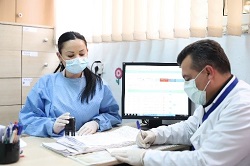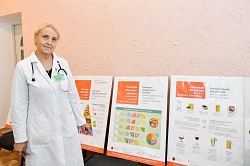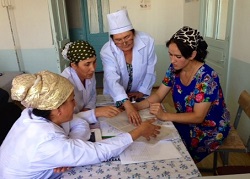Contributions Winter 2020/2021
07 December 2020
As the first vaccines are licensed and made ready for distribution and public expectations build for a rapid end to the COVID-19 pandemic, it is timely to consider what will be needed to achieve and sustain herd immunity.
Having been developed through unprecedented, accelerated pathways, the 90% plus efficacy of some of the severe acute respiratory syndrome coronavirus 2 (SARS-CoV-2) vaccines exceeds that of the 80% efficacy required for most vaccine licenses. However, the duration of protection from infection is expected to remain uncertain for a number of years. Early research on patients that have recovered from COVID-19 indicate that immunity may be of short duration – as has been evident in those who became re-infected post-recovery. Indeed, work on previously known corona viruses suggests that the duration of immunity to SARS-CoV-2 might be only 12–18 months.[1] According to a recent article by Anderson et al, a vaccine with these qualities would mean that a large proportion of the world population would need to be vaccinated to achieve herd immunity to halt the continued transmission of SARS-CoV-2.[2]
As some states in the northern hemisphere are on the cusp of immunising frontline health workers and the most vulnerable members of their populations, wide-scale deployment of COVID-19 vaccines is not expected until mid- to late 2021.[3] Global vaccine delivery is likely to scale up only gradually as manufacturing capabilities develop over 12–24 months after licensing. As such, the impact of vaccination on the transmission of SARS-CoV-2 will start slowly and build-up over a few years to reach target coverage levels. If countries do not reach high vaccine coverage levels, the virus will likely become endemic at a low level that will be determined by the extent of vaccine uptake, with peaks in winter and troughs in summer in the northern hemisphere.
Given the need for accelerated and targeted immunisation, countries will need to design structures for their COVID-19 immunisation programmes, including defining priorities for receiving vaccination, solving distribution challenges, and encouraging public acceptance of vaccination. Given the global climate of reduced trust in immunisation and public information, context-specific communication strategies on the vaccines being offered will need to be well thought-out and tested. A number of tools are available that can be adapted to support COVID-19 immunisation planning including WHO's 2017 training module for health workers “Conversations to build trust in vaccination", available as a PowerPoint presentation that can be accessed here:
http://awareness.who.int/immunization/programmes_systems/vaccine_hesitancy/en/
1 Kiyuka PK, Agoti CN, Munywoki PK et al. (2020) Human coronavirus NL63 molecular epidemiology and evolutionary patterns in rural coastal Kenya. J Infect Dis. 2018; 217: 1718-1739 https://pubmed.ncbi.nlm.nih.gov/29741740/
[2] Anderson, R.M, Vegvari, C., Truscott, J. and Collyer, B, (2020). Challenges in creating herd immunity to SARS-CoV-2 infection by mass vaccination. Lancet 396, 10263:1614-1616, November 21, 2020. https://doi.org/10.1016/S0140-6736(20)32318-7
[3] Krammer F. (2020) SARS-CoV-2 vaccines in development. Nature. 2020; 586: 516-517 https://www.nature.com/articles/s41586-020-2798-3
Contact
Kate Molesworth
Health and Social Development Adviser, Swiss TPH

Within the Sustainable Development Goals (SDGs), the adolescent birth rate is an indicator for sexual and reproductive health targets. Early pregnancy and childbirth represent a constellation of potential health risks and complications, social and educational exclusion, and economic disadvantage to mothers themselves, their children and their households.
From a public health perspective, adolescent pregnancy poses multiple risks, as complications of childbirth and unsafe abortion are leading causes of death among young women worldwide. According to WHO, an estimated 21 million young women aged 15–19 years in low- and middle-income countries (LMICs) become pregnant every year, and about 12 million of them give birth. Adolescent mothers have an increased risk of adverse health outcomes including obstetric complications, and children of adolescent mothers have an increased risk of infant and child mortality, preterm birth, growth failure, undernutrition, anaemia, and infectious disease. Adolescent mothers also have a high level of school dropout, as well as failure to enter the paid workforce, due to their double burden of household chores and child rearing. This results in a host of missed opportunities and economic disadvantage for girls who become mothers at an early age.
A recent study by Huda et al “Time trends and sociodemographic inequalities in the prevalence of adolescent motherhood in 74 low-income and middle-income countries: a population-based study" analysed data from 747,137 young women (aged 15–19 years) from 74 low and middle-income countries worldwide, using nationally representative Demographic and Health Surveys conducted between 1990 and 2018. The study calculated average annual rates of change in the prevalence of adolescent motherhood from the earliest to latest surveys to reveal national and regional trends.
The study found the highest regional prevalence of adolescent motherhood to be in sub-Saharan African countries and Niger had the highest prevalence at 40%. Globally, several high-burden countries experienced little change in prevalence over time – for example Bangladesh had only a 0·6% decline between 1993–2014. Sixteen high-burden countries experienced an increase in the prevalence of adolescent motherhood over time – for example Cambodia, had a rise of more than 2% between 2000–14 and the Philippines had an increase in just under 2% between 1993–2017. Sociodemographic inequalities were observed to exert a strong influence on the persistent prevalence of adolescent motherhood in the study countries. Some countries, notably Nigeria (1% between 1990 and 2018) and India (more than 4% between 1992 and 2015) experienced a decline in the prevalence of adolescent motherhood during the study period.
The study findings show that low- and middle-income countries experienced either a slow decline or a slight increase in adolescent births, which are associated with social, economic and urban-rural inequalities. They indicate that policy needs target the rollout of interventions based on contextual geographic and sociodemographic inequalities to reduce adolescent motherhood among the disadvantaged, and accelerate progress towards the adolescent sexual and reproductive health targets set out in the SDGs.
The full article can be accessed online here.
Contact
Kate Molesworth
Health and Social Development Adviser, Swiss TPH
Despite all the uncertainty and disruption
caused by the COVID-19 pandemic, IVCC achieved a significant product
development milestone in 2020. Thanks to
the continued support of its funding partners, including SDC, IVCC has, along with
its industry partners, moved three novel Active Ingredients (AIs) into the
development stage. This is the final
step when the end product is formulated, and the evidence dossier is compiled
for submission to the World Health Organisation for Pre-Qualification (PQ)
listing. If they pass the rigorous
regulatory review and performance hurdles, these new AIs will bring three new
modes of action to vector control and represent a promising step forward for
malaria eradication.
The development of novel AIs for use
against malaria carrying mosquitoes with new modes of action will provide
malaria control programmes with highly effective products with which to
practise best practice insecticide resistance management, vital for the
long-term sustainability of chemically based vector control.
The three new compounds have been
extensively tested against wild mosquitoes in the field and have been shown to
be able to kill pyrethroid-resistant mosquito strains. This provides the
opportunity to replace pyrethroids which have been used traditionally across
established vector control interventions such Long Lasting Insecticidal Nets
(LLINs) and Indoor Residual Spraying (IRS) but whose efficacy has been
compromised by the emergence of insecticide resistance. The benefits of restoring full effectiveness
of these tools cannot be underestimated in the goal to eradicate malaria.
Nick Hamon, IVCC’s CEO said: “Just over a
decade ago we started the process of screening over four million possible
compounds from various chemical libraries for malaria control. This milestone represents a significant step
forward in helping address the threat of insecticide resistance in malaria
carrying mosquitoes. I would like to
thank our industry partners for their commitment and expertise in progressing
these exciting new compounds and, of course, our funding partners like SDC for
supporting this critical product portfolio work”.
Notes.
IVCC is a not for profit the only Product
Development Partnership (PDP) working in vector control. IVCC was established
in 2005, through a $50million grant to the Liverpool School of Tropical
Medicine (LSTM) from the Bill & Melinda Gates Foundation, and is a
registered charity in the UK. IVCC works with stakeholders to facilitate the
development of novel and improved public health insecticides and formulations
to combat the rapidly growing problem of insecticide resistance. IVCC brings
together partners from industry, the public sector and academia to create new
solutions to prevent disease transmission.
IVCC is today funded by the Bill &
Melinda Gates Foundation, UKaid, USAID, Unitaid, The Swiss Agency for
Development and Coordination (SDC), The Global Fund and Australia Aid
Contact
Chris Larkin
Director, Communications and Operations, IVCC
christopher.larkin@ivcc.com
In-country activities

Finding opportunities among COVID-19 crisis: features of the support for PHC sector in Albania
One of the main objectives of the project Health for All is to build PHC models for the provision of home-based services to elderly people who lost their autonomy and as well as patients with advanced forms of NCDs or cancer in terminal phase. An important preparatory work was already completed in this regard in close collaboration with Albanian partners, before or at the beginning of the COVID-19 epidemic. The latest increased dramatically the need for home-based services due to people infected by SARS-CoV-2.
During the 10 months of coping with COVID-19, PHC services in Albania adapted and reacted to the needs emerged from the crisis. Following national guidelines and protocols, most of the COVID-19 patients with mild and moderate symptoms are being treated at home. In this new context, PHC teams are providing their services either remotely (via phone-calls or video-calls) or at home. Therefore, the COVID-19 pandemic created unprecedented needs and intensified challenges for the provision of home-based services.
In this regard, the Swiss project “Health for All”, has further amplified its support to the PHC sector by supplying primary healthcare centers with medical devices (portable oxygen concentrators, pulse oximeters and thermo-scanners) and additional PPEs (surgical masks, gloves, washable isolation gowns and disinfectant). PHC centers that have received oxygen concentrators offer healthcare services to a population of about 780,000 people. At the same time, HAP has provided training sessions on oxygen-therapy at home and COVID-19 educational materials targeting PHC professionals. Oxygen concentrators will be used by family medicine teams for the home-based treatment of patients with moderate forms of COVID-19 that are not affected by other chronic diseases. Beyond the COVID-19 epidemic, this equipment will continue to be used by physicians and nurses of PHC teams for the home care of patients with other chronic diseases in line with clinical protocols.
For the first time, primary healthcare centers will be able to provide home care to patients with COVID-19 as well as to elderly people and patients with non-infectious chronic diseases in need of oxygen therapy. “During these pandemic times, the support by ‘Health for All’ takes on a special importance especially with the provision of the oxygen concentrators and the training on oxygen-therapy at home. As we treat COVID-19 patients also at home, this equipment will improve our capacities and enable us to better help patients, those affected by COVID-19 and especially patients affected by other medical conditions”- states Dr. Lindita Blliku, family doctor in Ballagad, a rural health center in southern Albania. It can be said that “Health for All” pursued a double objective: support PHC teams for a better response to the COVID-19 emergency contributing at the same time to the enhancement of home-based services.
Contact
Irma Qehajaj
Communication Officer at Health for All Project

National Agency for Public Health’s Communication Campaigns
The NAPH has successfully carried out two national communication campaigns based on evidence and social marketing principles (i.e. partnering with a creative agency, using formative research insights for message development, and testing messages with consumer panels).
The Healthy Life Project supported the NAPH to create and launch the first health education campaign on the reduction of salt consumption. Based on recent evidence from a WHO dietary salt intake survey in Moldova, the campaign produced videos and animated spots, which were broadcasted on TV and online platforms. The target audience spanned men and women aged 18-70+ in rural and urban areas, with a special focus on changing eating and cooking behaviours and the gender issues around this. All content was produced in Romanian and in Russian language.

Reach of the salt reduction campaign
––The video spots achieved a cumulative TV market rate of 75.8%
––The spots were viewed 16.5 million times on TV and more than 40 000 times on social media channels
––Every day, about 900 000 people watched the spots on TV and more than 37 300 on social media
––Audio spots were broadcasted on four radio stations, which covered 61% of radio listeners in Moldova
––More than 500 Facebook and Instagram users took the online salt consumption test, most of them being women aged 18-34 years
––With a total market share of 77.8%, the campaign reached a large part of the population
The second campaign focused on trans fatty acids.
The video spot was broadcasted on 8 TV channels with national coverage.
––The spot had a coverage of 1,667,958 people or 93% of the audience of these channels
––On average, one person watched the video 7.98 times
––The radio spot was broadcasted 1010 times on 8 national channels and was heard daily by 173,206 persons
––For print media, 10 documents were developed that were picked up by 26 online news portals; on average, each material being read by 500 visitors of each portal
––The video from Comedy Zebra Show (influencers) was watched at least 1 time by 1,538,485 people, the video accumulating 631,988 unique views, 17,000 likes and 7,100
shares
–– With a total market share of 93%, the campaign reached the majority of the population
In a Knowledge, Attitude and Practice endline survey carried out in 20 rural raions of Moldova after the implementation of the 2 campaigns, 75% of respondents mentioned to have heard about the harms of consuming artificial fats or trans fats, and 70% indicated that they are making an active effort to reduce trans fats consumption, especially by lowering their use of margarine and spreads.
Authors
Ala Curteanu, Healthy Life Project
Florence Sécula, Swiss Tropical and Public Health Institute
Main project contact
Valeriu Sava
National Program Officer in Health, Representation of the Embassy of Switzerland to Moldova

WHO and Swiss TPH Assessment of Business Planning
The Business Planning tools are used annually by the Rural Health Centres under the direction of heads of the family medicine facilities, and are then consolidated by the Primary Health Care Managers at Rayon level. Although the term "Business Plan" is in reality a form of district planning, the title has helped in promoting the ideas of a more formal budgeting and organisational process.
In rayons where business planning is well established the facility managers are confident using the plans and appreciate the empowerment related to understanding their budget allocations. It is part of the process to involve communities in the planning and this has brought welcome transparency and improved relationships between facilities and the communities they serve. PHC managers at rayon level use the plans from the facilities as they form a good basis for budget setting and are useful for showing the effectiveness and functionality of facilities.
View publication
https://www.euro.who.int/en/health-topics/Health-systems/primary-health-care/publications/2020/assessment-of-business-planning-in-primary-care-facilities-in-tajikistan,-2019
Contact
Mouazamma
Djamalova, Senior Program Officer Health
Swiss Cooperation Office, Tajikistan
Linkedin | mouazamma.djamalova@eda.admin.ch
 Ukraine
Ukraine
An issue-oriented exploration of the Ukrainian healthcare arena - the main findings
Preamble “The sector seems to be in a low equilibrium trap. The health personnel are “at the mercy" of the Chief Doctors, the CDs are under the constraint of strict and unrealistic budget and staffing norms, the Treasury is constantly worried about theft and misappropriation and hence does not let go of input norms, the Ministry of Health (MoH) requires detailed data so that it can claim to exercise oversight, but does not use it de facto and cannot trust it either, the patients supposedly get free health services as guaranteed by the Constitution, but de facto need to pay “under" or “above" the table for almost everything" (Belli et al., 2015). Whether this dire picture still applies must be appraised. On the one hand, the reforms launched in 2017 have registered progress. On the other hand, they face formidable obstacles: widespread mistrust, a powerful and vocal opposition, pervasive red tape, the large shadow economy, the decaying health workforce, the financing squeeze and the ongoing epidemic limit the room for manoeuvring. The risk of a half-cooked outcome is real (Kutzin et al., 2010). Rationale and methodology In mid-2020, the Swiss Development Cooperation promoted a scoping review of the healthcare arena, as a contribution to its own programming, as well as to the broader policy discussion. The exercise was intended to complement the available documentation, which mainly focussed on formal aspects. Thus, the focus of the scoping review shifted from hardware to software, and from front stage to back stage. The scoping review adopted an original approach, by focussing on issues rather than proceeding by health system component, as it is customary. Issues recurring across available documents were extracted and progressively clarified. As the exploration proceeded, new issues gained prominence and were added. Nineteen interviews took place and three thematic round tables were convened. The emerging findings were submitted to informants, eliciting valuable feedback. The exchanges with informants were extremely rich, signalling an appetite for discussing prominent issues, as well as neglected ones. This scoping review cannot be conclusive, nor can it propose clear-cut measures to stakeholders. The exploration is not yet saturated and should not be abandoned. Nurturing an inclusive policy discussion founded on an enhanced awareness of the issues at stake seems the way to go. Highlights The information landscape. “No data no problem, might be the motto of the state administration" (informant). Routine information systems are fraught to the point of being useless. Data collection flows are disconnected and unreliable. Examples of forged or massaged data abound in the literature. As the scoping review proceeded and the spectrum of informants expanded, the resulting picture increasingly diverged from official documents. The socio-political context. The legacy of the past looms large in determining present and future developments. A political lens permeates the interpretation of the (never-ending) transition: socialist vs. capitalist, collective vs. individual, social vs. medicalised, entitlement vs. precariousness, predation vs. coping. Three decades of policy indecisiveness are the natural result of unstable governance. A dynamics of resistance to change recurs over time and across services. Poor dialogue between stakeholders, obstinate adhesion to obsolete models and dysfunctional institutions incline to issue provisions without enforcing them, ensure that every change attempt looses momentum, old and new ways of working coexist, and both effectiveness and efficiency suffer. Mindsets inform every aspect of life, including healthcare provision. They should not be engineered, but respectfully questioned. Western mindsets should be questioned too. Without taking into the due consideration the mindsets at play and their mutual interactions, the results of interventions are likely to deviate from expectations. Indigenous conceptions often diverge from internationally-accepted ones. Another pervasive factor is the partitioning of the healthcare arena by administrative domains. Of great significance is the split modus operandi of managers, who must comply with strict norms and procedures, while having to make ends meet, which is possible only by ignoring or bending formal rules (Belli et al., 2015). Widespread mistrust colours the relationships of citizens with public healthcare provision. For instance, low vaccination uptake is induced by a “long-standing culture of distrust – physicians do not trust the government, patients trust neither the government nor their physicians, and, consequently, no one is able to put their faith in governmental immunization program" (Bachmaha, 2016). Mistrust affects healthcare demand, personal and collective behaviours, and the effectiveness of health services. As other intangible factors, trust is often overlooked by health decision-makers driven by technical considerations. However, mistrust causes considerable waste, in terms of multiple consultations, exams and treatments, which in turn may have iatrogenic effects. An impoverished health system facing rising health needs cannot afford to be inefficient. The shadow economy of healthcare provision is the elephant in the room. Plenty of studies prove its pervasiveness (Stepurko and Belli, 2018). A productive policy debate would accept that informal charges are the unavoidable consequence of underfunding (Kutzin et al., 2010), and should be duly analysed in order to be rationally managed, rather than condemned on moral grounds. Most interventions target formal transactions, assuming that 'corruption' will be repressed or go away in the new healthcare environment. Focussing only on the formal portion of the health economy may lead to adopting flawed measures. The health workforce is grappling with a severe crisis. Mirroring the population at large, health workers are aging, unhealthy, under-paid, dissatisfied and disoriented, looking for exit options. Productivity is low, due to the poor working environment, questionable practices and wasteful paperwork. The mismanagement of the health workforce is entrenched, generating much dissatisfaction. Nursing contingents are shrinking faster than medical ones. Some specialist skills are lacking. Doctors move abroad in search of better job prospects. Nurses enjoy fewer flight options, due to less tradable qualifications. Enrolment in healthcare training programmes is decreasing. Moreover, many healthcare graduates do not opt for a public employment. Some find jobs in the growing private market, while others might leave the healthcare arena. The magnitude of unemployment among health professionals is unknown. Thus, the large, unproductive health workforce inherited from Soviet times is shrinking, against a declining, aging and sick population. Health reforms act as a lightning rod, attracting lavish praise as well as criticism (both fair and unfair). But to explore the healthcare arena with these blinkers would be reductive. Many aspects not yet directly touched by reforms will inform their success. Competing lobbies squabble over reforms. Health reforms are however too broad and composite an umbrella to be discussed as a whole. Each reform component should be studied in its own right, and for its present and future contributions to the whole health system. Moving away from the reform contents, towards the appraisal of their feasibility, and the realistic measures that can be taken in such a strategic and operational quandary, might be beneficial. According to some informants, communication has been a key weakness of the reformers, whose energies have been absorbed by fighting the conservatives. On the other hand, the reforms launched in 2017 had the merit of raising the political standing of health care, which was previously neglected. Quality of health care is recognised as poor, hence requiring purposeful interventions (Stepurko and Belli, 2018). An ominous marker of poor quality of care is the high proportion of health workers infected with Covid-19. Such indicator leads to another one, i.e. the iatrogenic effect of health care. Lax infection control within health facilities has been recognised since Soviet times and never adequately addressed. Additionally, the atrophy of supervision, evaluation and regulation functions is matter of concern (Gadsby et al., 2017). The ingrained perception of such functions as threatening, hence to be evaded or gamed, impedes progress. The reforms under way are changing the interplay of incentives, which may temporarily spur motivation. Adequate incentives cannot offset inadequate competences, obsolete healthcare practices, mismanagement or poor working conditions. Health status and needs suggest fundamental societal ills, whose effects cannot be addressed by health care alone. “Ukraine suffers more afflictions than Job" (Twigg and Merry, 2014). The country has been in the grip of a severe demographic and health crisis, whose origins remount to Soviet times. Mortality skyrocketed after the demise of the URSS, and recovered slowly afterwards, remaining high to these days. Low fertility and massive outmigration contributed to the fastest population contraction registered in Europe. Moreover, the hospital-biased healthcare provision model is ill-equipped to deal with social determinants of health demanding population-based responses (Hankivsky et al., 2017). Refocusing attention on the wider determinants of health, beyond the usual emphasis on health conditions would give precedence to different measures. Pervasive red tape stifles initiative and deters progress. Like in an archaeological site, layers of provisions and procedures have accumulated over time, suffocating initiative and operations. “When a new central regulation is introduced, [..] everyone adjusts to the new requirements without changing the substance of established routines" (Belli et al., 2015). The interpretation of existing norms and regulations shapes their application. A diffuse state architecture with unclear and cumbersome provisions slows down legislation and its enforcement. The disrespect of the norms is however tolerated, provided it does not challenge the status quo. “It is easier to do nothing than doing something on the fringe of the allowed" (informant). Some strategic considerations suggested by the emerging picture. Given the crushing circumstances, holding the healthcare system together might take precedence over reforming it. Doing the same things better leads into to a blind alley. Focussing interventions on the state administration looks like a poor bet, given the chronic ills affecting it. Overall, a shift from state to society (regarded as strong by many watchers) is recommended. Alleviating bottlenecks with pragmatic measures may be more beneficial than the radical redesign of formal structures. Interventions of a supportive nature, aiming at mending some of the potholes in the dilapidated road, are advisable. Whatever the decisions taken in the volatile political arena, travellers will appreciate a smoother ride, and might go further. Options to be considered: - Addressing the mistrust of citizens in the provided health care demands the acceptance of their concerns. Sound, two-way communication is as important as technical quality in determining healthcare outcomes. Solid information about contested or overlooked health issues needs to be provided by autonomous health systems analysis hubs, protected from state, business and donor interference.
- An inclusive debate about the wider determinants of (poor) health and on the needed responses should be promoted. Such an initiative might bring together progressive actors from both sides of the reform divide. In the long run, moving forward in this domain might provide the best returns.
- Managing the health workforce crisis might constitute the most needed, as much as the most demanding intervention. The starting point might be that the ailments of the health workforce are too severe to be cured quickly by straightforward measures. For some time, palliative care might be needed to contain the deterioration.
- Encouraging the slimming of legal provisions, norms and procedures, which constrain operations and curb progress, should gain the attention of supporting partners. Otherwise, the system will remain inefficient and ineffective, even if its architecture changes.
- Brokering a productive dialogue on health reforms, in order to lead opponents to understand the views of each other. Mutually-acceptable deals in the pursuit of systemic gains should be agreed by reformers and conservatives alike. Progress must be attained by designing a healthcare architecture perceived as indigenous and acceptable by influential players, while fencing it from political quarrels.
|
Selected References- Bachmaha, M. (2016) Vaccination crisis in Ukraine: its origins and consequences. Krytyka. Issue 9-10, 227-228.
- Belli, P. Dzhygyr, Y. Maynzyuk, K. (2015) How is it working?: A new approach to measure governance in the health system in Ukraine. The World Bank.
- Gadsby, E. Peckham, S. Kvit, A. Ruskykh, K. (2017) Public health programmes and policies in Ukraine: development, design and implementation. Centre for Health Services Studies, University of Kent and Kyiv Economics Institute, Kyiv School of Economics.
- Hankivsky, O. Vorobyova, A. Salnykova, A. Rouhani, S. (2017) The importance of community consultations for generating evidence for health reform in Ukraine. Int J Health Policy Manag. 6(3), 135–145.
- Kutzin, J. Jakab, M. and Cashin, C. (2010) Lessons from Health Financing Reform in Central and Eastern Europe and the Former Soviet Union. Health Economics, Policy, and Law. 5(2): 135–47.
- Stepurko, T. and Belli, P.C. (2018) Innovating health-care governance in Ukraine: formal and informal practises. Chapter 8 in: Zvonareva, O. Popova, E. Horstman, K., editors. Health, Technologies, and Politics in Post-Soviet Settings. Palgrave Macmillan, Cham.
- Twigg, J. and Merry, E.W. (2014) Ukraine's real crisis: a demographics and health time bomb. The National Interest. https://nationalinterest.org/feature/ukraines-real-crisis-demographics-health-time-bomb-11851.
- Yankovsky, S. (2011) Neoliberal transitions in Ukraine: The view from psychiatry. Anthropology of East Europe Review. 29(1).
Contact
Barbara Profeta
Regional Advisor & Health Focal Point, SDC HQ
LinkedIn | barbara.profeta@eda.admin.ch
Enrico Pavignani
enricopavignani@hotmail.com
